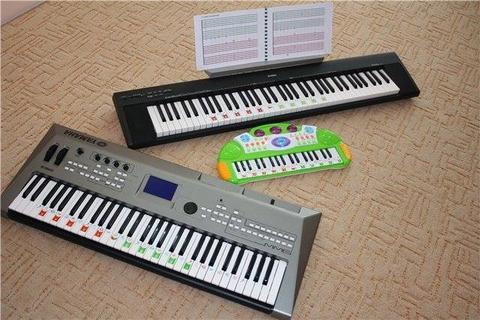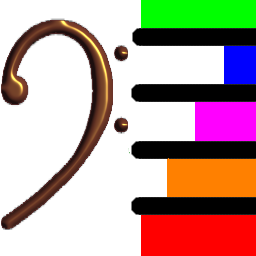Preparatory B (from 3 to 5). Lesson 46
Previous Lesson Next Lesson
To all lessons

Your FREE Demo version is here
Your full version access is here
Today in our Pedagogy class we are going to learn, how attention of early learners spending its energy on pressing the key.
Pressing the key. 
This seemingly simple action is also composed of a number of physical components. Thus, if you ask the beginner to press a tighter piano key, the sound will be weak and muted.
For the student’s attention to be entirely focused on pressing the key, he should not be distracted by his search for it. With little knowledge of piano geography, forcing attention to focus on deciding how hard (“to sink into the key”) to press the key is the major cause for student’s hand muscle clamping.
A decision of how hard to press the key is an objective physical problem. It is important to remember that the hand of a child is still developing and the instrument with the “tight” keyboard can distract him from the study of piano geography. If your toddler's attention is not ready to work with the impact force, the time delay on the Gentle Piano timer will increase. It is important to always watch the timer and try not to exceed the “normal temperature” of this “thermometer.”
The next steps of development will be: the ability to play staccato, legato, and non-legato; the ability to play softly, loudly as well as to use creative touch.
...
Piano Hand Position Exercises by Olga Egorova: "Sharp Pencil"
This exercise helps students to feel the sharpness of their fingertips with the help of a small pad of the flat part of the pencil. This is how the pianist's fingers should touch the keys of the instrument. A video lesson was prepared by Olga Egorova, a teacher at Soft Mozart Academy in Moscow
....
 Bass Staff Puzzle®
Bass Staff Puzzle®
Goal:
These modules help the player to memorize the position of any music note on the Bass and Treble staves. Watch video tutorial.

Rules
Use Left or Right arrow on the computer keyboard to place music notes on corresponding lines and spaces of the Bass or Treble staff. Use the Space key to make a note fall faster if the note is in the correct position. The correctly positioned note images compose a picture and give you points. Every completed picture opens a part of the portrait of Mozart in the right part of the screen. You have 49 different pictures to open Mozart's portrait and finish the module. Beginners should start by only playing for a short time. Please, contact our professionals for your customized guide lines playing this module!
Computer control keys
LEFT arrow - Move falling notes left or down.
RIGHT arrow - Move falling notes right or up.
Space key - Make note fall faster.
A - Switch the program to Alphabetic (A, B, C ...) note names
I - Switch the program to Italian (Solfeggio: Do, Re, Mi...) note names
Ctr-X - Exit the program.
Note name convention
Soft Mozart®uses both Alphabetical music notation - C, D, E, F, G, A and B, and “Solfeggio” or Italian music notation - Do, Re, Mi, Fa, Sol, La and Ti.
Program Keys
To switch to the Alphabetical name convention press computer key A.
To switch to the Italian name convention press computer key I.
All Italian names have special mnemonic symbols to recognize and remember note names:

We recommend...
...the use of the Italian (Solfeggio) note name convention by any beginner or child. Its note symbols are very easy to identify and remember, even by those who can't read yet. And most importantly, Italian note names are specially designed for singing. The singing of note names helps any beginner to form a crucial musical skill to connect a pitch of a note with its name, and tie together his or her ear, voice and brain.
Tips
- Play several notes in a row correctly (the number depends on the module stage) and the program will switch to the next level of difficulty. You will get more points for every correctly played note, but the notes will move faster.
- If you make two mistakes in a row, the module will switch to a lower level of difficulty
Few words...
These modules train and develop a basic skill in music reading - to attribute any note name to a corresponding line on the Bass and Treble staves. The original design asks the player for a momentary reaction in recognizing correct lines. In the advanced level only the subconscious vision of the correspondence of lines and notes may help the player finish the module successfully. An advanced student can finish this module in 25 minutes (13 minutes module time); beginners should start by only playing for a short time.
For the age from 3 to 5 it is better to play the  Bass Staff Puzzle® from 5 to 10 minutes.
Bass Staff Puzzle® from 5 to 10 minutes.
....
 If your child is developing faster or slower than our plans suggest, we recommend writing to us at admin@softmozart.com to start working with our certified specialists.
If your child is developing faster or slower than our plans suggest, we recommend writing to us at admin@softmozart.com to start working with our certified specialists.
 Gentle Piano®
Gentle Piano®
1. "Little dog gone" from the Nursery 1 Album
Let's master playing the piece with the TEACHING VIDEOS using separate and both hands:
With metronome
With no metronome
2. Music Sight-Reading Prokofiev "Peter and the Wolf" - "Cat's Theme"
Play L1
....
Listen to Prokofiev "Peter and the Wolf" - "Cat's Theme":
....
Visit our Soft Mozart forum and start your progress diary here. Use the current year section. This is the place for you to ask questions and share your experiences.
At least 2 photos and 1-2 videos of the listed activities will count towards your child's credits for the graduation DIPLOMA. Please upload the video to You Tube, copy the address from the BROWSER window and paste it into your Progress Diary. Do not forget to indicate the year and type of work in the description of your Soft Mozart Academy photo / video.
Sincerely Yours,
Hellene Hiner

Video success:
 Would you like to receive lessons by email weekly? Subscribe to the e-mail lesson here:
Would you like to receive lessons by email weekly? Subscribe to the e-mail lesson here:
All the lesson plans:
For 2+ students
For students from 3 to 5
For students 5+
Always check here, if we have any recital! You and your child will benefit a lot from participating in our concerts!
Your place to start your progress diary is here.

